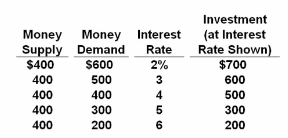Refer to the table. Suppose the legal reserve requirement is 10 percent and initially there are no excess reserves in the banking system. If the Fed wished to reduce the interest rate by 1 percentage point, it would:

A. sell $10 of government bonds in the open market.
B. buy $100 of government bonds in the open market.
C. sell $100 of government bonds in the open market.
D. buy $10 of government bonds in the open market.
D. buy $10 of government bonds in the open market.
You might also like to view...
The impact of Hurricane Katrina on consumers in the economy was to make them very pessimistic about their future incomes. How does this increased pessimism affect the aggregate demand curve?
A) This will move the economy down along a stationary aggregate demand curve. B) This will move the economy up along a stationary aggregate demand curve. C) This will shift the aggregate demand curve to the left. D) This will shift the aggregate demand curve to the right.
A increase in net exports
a. shifts the aggregate demand schedule upward b. shifts the aggregate demand schedule downward. c. does not shift the aggregate demand schedule. d. decreases saving.
A plan to revitalize the downtown area of a struggling city would fulfill which of the following goals to address poverty and inequality?
A. Economic development B. Safety nets C. Redistribution D. None of these is true.
In the 19th century John Deere took out a patent on a newly designed plow that incorporated steel to make plowing faster. Many farmers bought plows from his company and he made millions. This example shows that patents turn an idea into a
a. public good. b. societal good. c. private good. d. normal good.